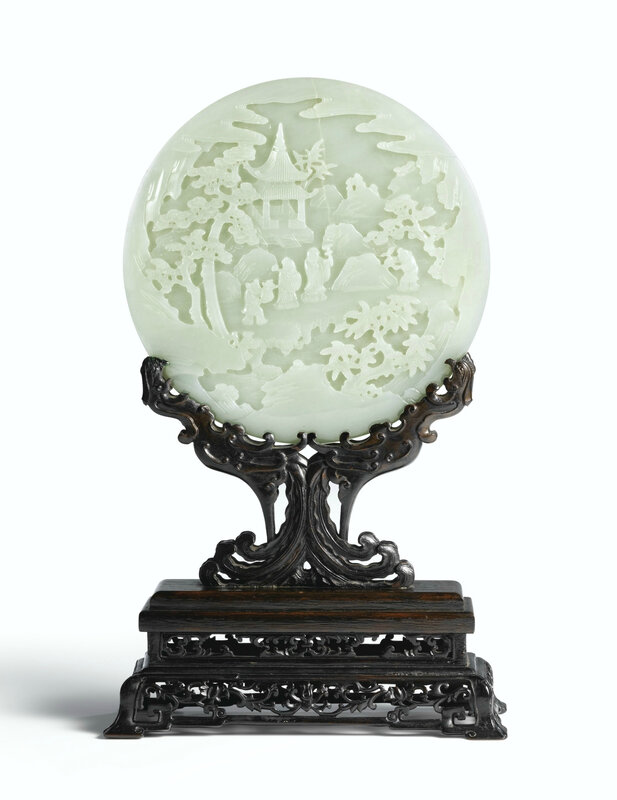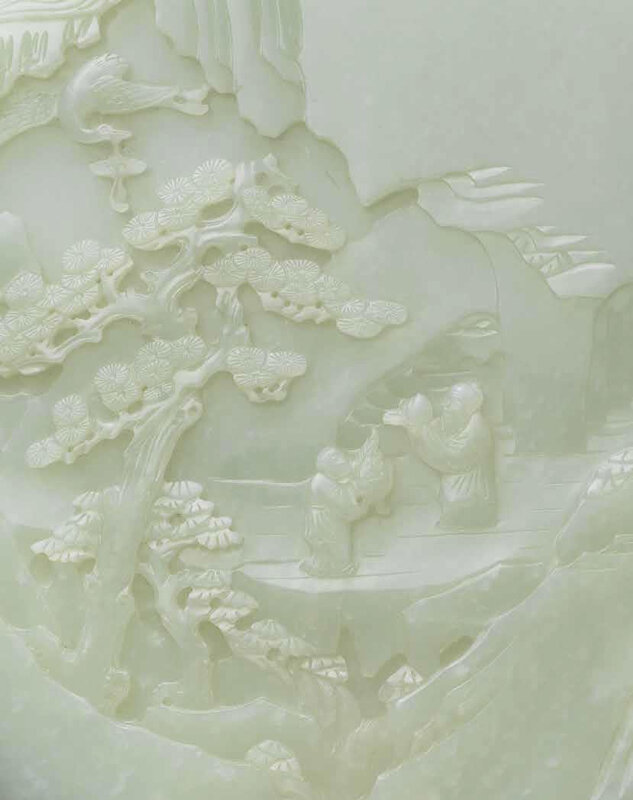The Prince Kung Jade Table Screen. A magnificent Imperial white jade circular table screen, Qianlong period (1736-1795)
Lot 90. The Prince Kung Jade Table Screen. A magnificent Imperial white jade circular table screen, Qianlong period (1736-1795); 21cm (8 1/3in) diam. Estimate: HK$4,000,000.00 - HK$5,000,000.00 (€ 450,000 - 560,000). Unsold. © Bonhams.
Of circular form, dexterously carved on one side with a mountainous landscape scene depicting an Immortal holding a peach, facing his attendant carrying two fish, both standing on a ledge above a flowing stream, below a pavilion partially hidden in the mountains, opposite a lofty pine tree above a wutong tree, with a crane in flight carrying a musical chime stone below cloud scrolls, the reverse finely polished and left uncarved to display the attractive stone of even white tone, the wood stand carved in openwork with two conjoined archaistic phoenix on a rectangular lotus base.
Provenance: Puwei (1880–1936), Prince Kung (Gong) of the First Rank
Yamanaka & Co. Ltd., New York
American Art Galleries, New York, The Remarkable Collection of the Imperial Prince Kung of China: A Wonderful Treasury of Celestial Art 27 February 1913, lot 120
Nagatani, Chicago
Milwaukee Art Museum
Christie's New York, 22 March 1999, lot 30
An Asian private collection
Published and Illustrated: American Art Galleries, New York, The Remarkable Collection of the Imperial Prince Kung of China: A Wonderful Treasury of Celestial Art 27 February 1913, lot 120.
Note: Prince Kung (or Gong) of the First Rank, was the grandson of Yixin, the first Prince Kung, who was the sixth son of the Daoguang emperor. He was to be the last Prince Kung. The turbulent times following the demise of the Qing dynasty saw Puwei, Prince Kung, seeking refuge with the German protectorate and in dire economic straits. He therefore offered his mansion and properties as a mortgage to the Catholic Benedictine Order. However, it was to Yamanaka Sadajiro, who opened a store in New York's West 27th Street near Broadway, that Puwei sold the bulk of the Prince Kung Mansion Collection. Yamanaka then proceeded to offer the collection for sale in 1913 at the American Art Association.

Puwei (1880–1936), Prince Kung (Gong) of the First Rank.
Such superb white jade stone, particularly of such impressive size, first became available following the Qianlong emperor's conquest of the Dzungar Khanate between 1755 and 1759, where much of the jade was sourced. The natural translucency of the carefully chosen jade stone, finely polished to a soft, glossy sheen, is further enhanced by the master carver's intentional contrast between the skillfully carved multi-layered landscape to one side, and the lustrous uncarved surface to the other side, reveling in the exceptional quality of the jade stone. The unusual thickness of the jade disc, measuring approximately 1cm deep, still allows the light to pass through the stone enhancing the varying depths of the carved pictorial scene whilst remaining unaffected by the uncarved reverse, thereby creating a miniature world for the viewer to contemplate and 'escape' to from the toils of daily life.
The Qianlong emperor advocated that jade mountains and carved panels should be inspired by paintings of past masters. It is recorded that a number of classical paintings from the emperor's own collection was to be replicated in jade, such as the well-known painting Travelers in the Mountain, by Guan Tong, active during the Five Dynasties (907-960 AD). In one of the emperor's poems, as discussed in an essay by Yang Boda, Arts of Asia, 'Jade: Emperor Ch'ien Lung's Collection in the Palace Museum, Peking', March-April 1992, the emperor noted in reference to a jade panel:
'This piece of precious jade slab is from Khotan. It is unsuitable for making vessels such as the dragon hu and animal lei. In order to fully utilise it, it is to be carved into a panel with the scene of "A Riverside City on a Spring Morning". Imagination is exerted to turn the natural undulation or ruggedness into an appropriate landscape... It takes ten days to carve a tiny bit of water and five days to shape a piece of rock. The crafting is indeed very time-consuming.'
The present lot is mounted on an elaborate wood stand and would have been displayed in one of the halls in the Prince Kung Mansion in Beijing.
Compare with a similarly carved white jade circular screen, Qianlong mark and period, with the front side depicting three Immortals and the reverse also left uncarved, illustrated in the Compendium of Collections in the Palace Museum: Jade 8 Qing Dynasty, Beijing, 2011, p.180, no.142. See also another white jade circular screen, Qianlong, illustrated in Christie's 20 Years in Hong Kong, 2006, p.370, which was sold at Christie's Hong Kong, 1 December 2010, lot 3006. A further white jade circular screen, was sold at Sotheby's Hong Kong, 8 October 2013, lot 3042.

A magnificent white jade circular table screen, Qianlong period (1736-1795); 9 1/2 in. (24.1 cm.) diam. Sold for HKD 11,860,000 at Christie's Hong Kong, 1 December 2010, lot 3006. © Christie's Image Ltd 2010.
Finely and deeply carved on one side with a mountainous landscape scene of scholars approaching a pavilion situated amidst pine trees, their attendants playing musical stones, the reverse with deer at rest under trees, both scenes framed by tall mountains and wreathed with scrolling clouds, the stone of semi-translucent even white tone, box, wood stand.
Provenance: Previously sold at Christie's Hong Kong, The Imperial Sale, 30 April 2000, lot 534.
Literature: Christie's 20 Years in Hong Kong, Chinese Ceramics and Works of Art Highlights, Hong Kong, 2006, p. 370.
Note: The present circular plaque is one of the finest white jade carvings of the 18th century Qianlong period. The attractive material is finely polished to a soft, glossy sheen. Jade was admired for its tactile quality and as early as the 9th century and Tang dynasty, scholars wrote poems praising its clarity and purity, and allegorizing these qualities with the aspirations of men.
One of the most fascinating aspects of this screen, is not only the large size but also the translucency of the carefully chosen material. Even though the panel measures approximately 1cm. in thickness, when light passes through the stone it enhances the differing depths of the picturesque landscape scene. The viewer is easily transported into a tranquil place of rivers, flowing alongside lofty mountains, and the subtle wispy clouds above that form the frame-like border. The lapidary artist has masterfully captured an ethereal vignette where minute figures are seen to be in deep conversations against a backdrop of a vast and idyllic landscape.
Emperor Qianlong particularly advocated that jade mountains and carved panels should carry the spirit of paintings by famous past masters. It is recorded that a number of classical paintings from the Emperor's own collection were ordered to be reproduced in jades such as the well-known painting entitled, Travellers in the Mountain, by the eminent painter Guan Tong of the Five Dynasties (AD 907-960). Jade landscape carvings of this type were particularly favoured by the Emperor. In one of Qianlong's poems, as discussed in an essay by Yang Boda, cf. Arts of Asia, 'Jade: Emperor Ch'ien Lung's collection in the Palace Museum, Peking', March-April 1992, the Emperor noted in reference to a jade panel:
'This piece of precious jade slab is from Khotan. It is unsuitable for making vessels such as the dragon hu and animal Lei. In order to fully utilise it, it is carved into a panel with the scene of "A Riverside City on a Spring Morning". Imagination is exerted to turn the natural undulation or ruggedness into an appropriate landscape... It takes ten days to carve with a tiny bit of water and five days to shape a piece of rock. The crafting is indeed very time-consuming'.
The circular panel is mounted on an elaborate wood stand and would have been placed to decorate the side or main tables in the Qing dynasty imperial halls.
A pair of white jade screens of similar size and depicting very similar scenes, almost certainly from the same series and probably by the same group of craftsmen was sold at Christie's Hong Kong, Important Chinese Jades from the Personal Collection of Alan and Simone Hartman, Part II, 27 November 2007, lot 1511.

A finely carved white jade circular table screen, Qing dynasty, Qianlong period (1736-1795); diameter 21 cm., 8 1/4 in. Sold for 3,880,000 HKD at Sotheby's Hong Kong, 8 October 2013, lot 3042. © Sotheby's.
Cf. my post: A finely carved white jade circular table screen, Qing dynasty, Qianlong period (1736-1795)
Bonhams. Fine Chinese Ceramics and Works of Art, Hong Kong, 27 november 2018.

/https%3A%2F%2Fprofilepics.canalblog.com%2Fprofilepics%2F1%2F0%2F100183.jpg)
/https%3A%2F%2Fstorage.canalblog.com%2F03%2F02%2F119589%2F96711876_o.jpg)
/https%3A%2F%2Fstorage.canalblog.com%2F11%2F31%2F119589%2F94773502_o.jpg)
/https%3A%2F%2Fstorage.canalblog.com%2F20%2F83%2F119589%2F94772815_o.jpg)
/https%3A%2F%2Fstorage.canalblog.com%2F26%2F72%2F119589%2F75604929_o.jpg)
/https%3A%2F%2Fstorage.canalblog.com%2F59%2F60%2F119589%2F26458628_o.jpg)





/image%2F1371349%2F20240406%2Fob_a54acc_435229368-1644755382961141-18285727260.jpg)
/image%2F1371349%2F20240229%2Fob_b1ea4c_429582962-1625285201574826-43586635599.jpg)
/image%2F1371349%2F20240229%2Fob_84bc3b_429558450-1624783464958333-37673404077.jpg)
/http%3A%2F%2Fstorage.canalblog.com%2F36%2F88%2F119589%2F129555285_o.jpg)